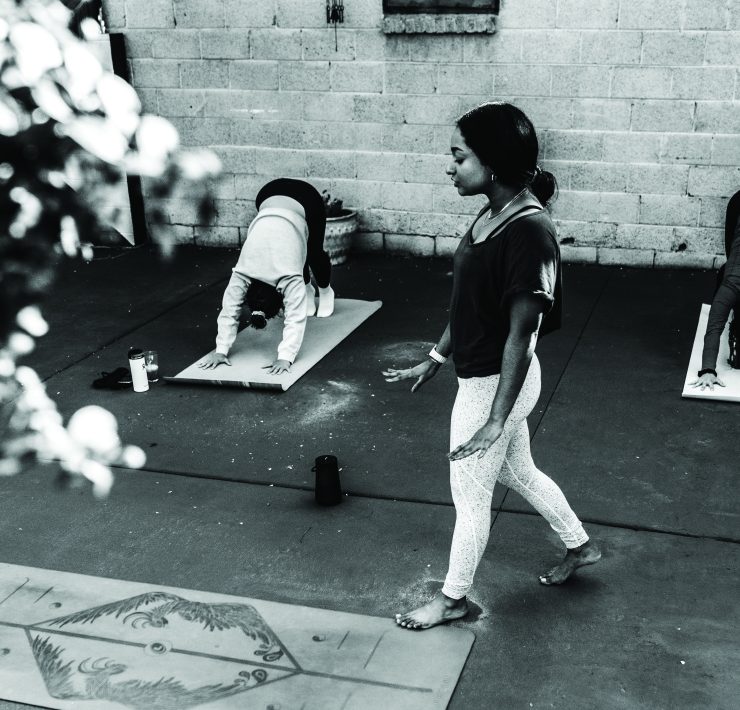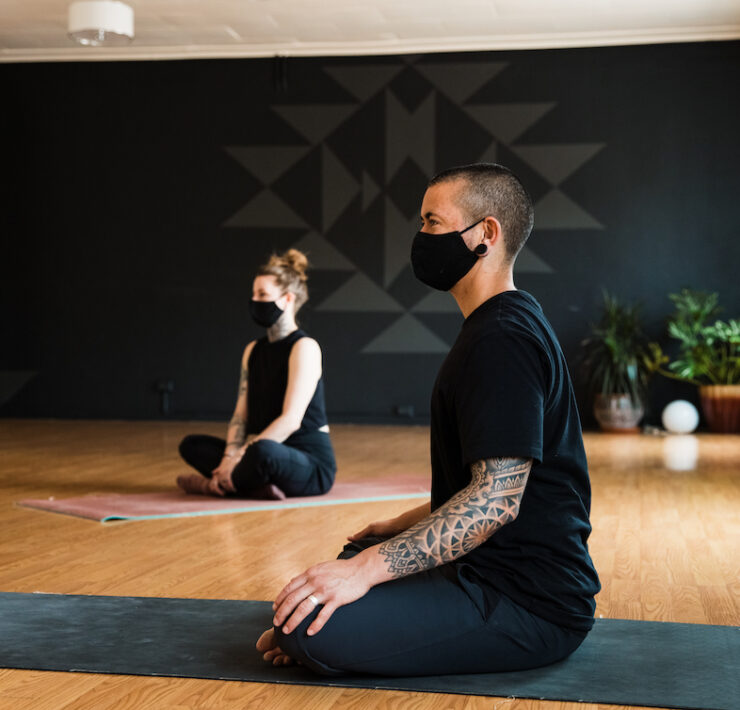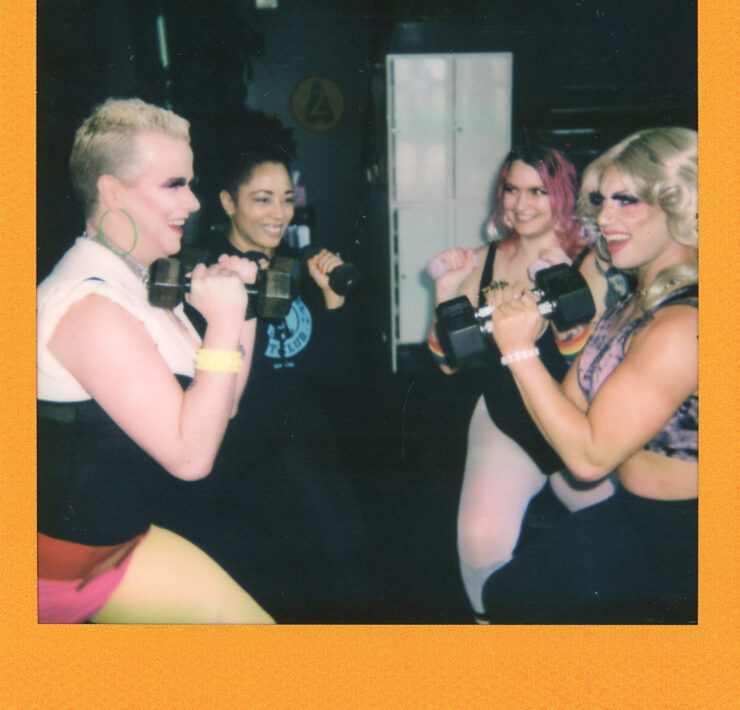Yoga: Good for All Bodies, All Minds

Every Sunday morning at 11 a.m. at Dawson Park in Longmont, families flock to the grass in hopes of stretching the last bit of summer. As they paddleboard, boat, and barbecue, a gaggle of queers gather under a tree whose leaves act as a source of shade. They huff through planks and then bring their hips up into downward dog before relaxing back into child’s pose, cradled by the soft earth beneath their mats.
They have come together for Rainbow Karma Yoga.
The event is hosted by Out Boulder, an organization that provides services, programs, and support for Boulder County’s LGBTQ community. Out Boulder’s powerhouse director, Mardi Moore, approached newly minted yoga instructor James Allison about leading an LGBTQ yoga class. The previous instructor of the class had left, and Allison, already involved with the organization as a volunteer, decided to marry two of his passions: helping the LGBTQ community and yoga.
One of the students at Rainbow Karma Yoga is Logan. He’s new to the class, but he exudes relaxation. He’s practiced yoga for several months now, ever since a traumatic life incident forced him to find new ways to work through everything.
“Mentally, spiritually, and physically it’s been a big release of negativity and a door to becoming one with myself and the universe,” he said. “I feel stronger as a person and more confident from being closer to myself.”
This is a sentiment shared by Jordan Smiley, a transgender, full-time yoga instructor, mentor, and trainer of yoga instructors who lives and practices in the Denver area.
“Yoga asks us to soften our grasp on what we think we know, especially about ourselves, and open our hearts and ears to experiences and voices we would otherwise habitually silence. We become synthesis detectives, fearless tellers of the truth, and beings who accept total responsibility for the digestion of their human experience.”
The benefits of yoga can be especially important for members of the LGBTQ community like Logan.
“The truth is that queer and transgender populations experience higher levels of trauma,” Smiley said. “Yoga reduces stress hormone levels in only a week of practice and teaches the body and mind ways of processing and responding to stress. All of this is the equipment that marginalized people need to survive, align, and thrive, and ultimately to re-inform a culture that is learning our value.”
An Ancient History
People across the country are falling increasingly in love with this ancient practice. Yoga is so old—some researchers estimate its emergence as early as 10,000 years ago—that the first records of it were written on palm leaves. Although these records are lost to the ages, we know that the word ‘yoga’ emerged in the Indus-Sarasvati civilization in Northern India.
Yoga is first mentioned in the sacred texts, Vedas, which contained songs, rituals, mantras, and other materials used by Brahmans or Vedic priests. Brahmans and Rishis, mystic seers, developed the practice and wrote many scriptures about yoga and their beliefs.
From there, yoga morphed as different cultures adapted and changed it. Approximately 1,700 years ago, an ancient Indian sage, Patanjali, composed the Yoga Sutra, comprised of 195 words of wisdom about yoga. In it, he defined the practice as “योग: चित्त-वृत्ति निरोध.” Swami Vivekananda, an Indian Hindu monk, translates this to “Yoga is the inhibition of the modifications of the mind.”
Modern Intersectionality
Yoga spread its ancient roots throughout the world—and especially Denver. Splashed across the covers of magazines in every grocery store checkout line are skinny, white, cis women in varying states of bendiness intended to show off their sculpted abs, shoulders, biceps, et cetera. Yoga, these photos declare, is for people like this. But that couldn’t be further from the truth.
“Yoga is not now, nor has it ever been, a practice aimed at physical mastery for its own sake,” wrote Susanna Barkataki in an article for Decolonizing Yoga. “Yoga was originally intended to prepare the body as a foundation for unity with the spirit.”
The message? Yoga is good for everyone.
“Yoga means liberation from every construct, including that of race, gender, time, space, location, identity, and even history herself,” wrote Barkataki. The benefits of yoga are immense and are something that every individual can experience.
“I see time and time again… how the core, underlying benefit of yoga is learning more about your body and self,” Anna Guest-Jelley said. She’s the founder of Curvy Yoga, an online yoga studio and teacher training center that “helps people of all sizes find true acceptance and freedom both on and off the mat.” That last distinction is important.
“The benefits of [yoga] extend so far,” she said. “Figuring out where it might be useful to increase flexibility or build strength in your body, learning how to adapt different poses to your body, and even discovering what your body signals are for and how to make decisions in your life.”
She’s an advocate for the importance of inclusive—and accessible—yoga. Her online studio not only offers different pay scales, but it’s filled to the brim with an abundance of resources. These resources can help anyone from yoga newbies to those who already have a regular practice.
There are tons of YouTube channels cropping up that offer free yoga practices. Adriene Mishler, owner of the YouTube channel Yoga with Adriene, has amassed a following of millions; 3.8 million people subscribe to her channel. She’s a yoga instructor who has posted hundreds of videos that are all free to access. In her videos, she’s careful to use inclusive language and keep the practices open to everyone.
Her mantra? “Find what feels good.” It isn’t about the shapes, she tells her audience time and again; it’s about how it feels. Many of the YouTube yogis offer the option of a regular, quality practice to those who may be uncomfortable in a traditional studio environment, or who are unable to access those environments because of money, time, distance, and other factors.
“When it comes to her online practice, Guest-Jelley also focuses on helping studios to be more inclusive.” She helps studios to be more inclusive. “[Studios] can seek out and receive training in how to make the poses they teach more accessible to more bodies,” she said. Reviewing marketing materials and responding to student feedback are important to ensure that a studio remains a safe and inclusive space for all. In the end, though, Guest-Jelley said, “It all boils down to being open to learning and change and not assuming that just because you’re welcoming in your heart that you automatically have the necessary tools to make that a reality.”
Smiley cautioned against this as well. “It is possible to be situated in a mindfulness community and to bypass color, gender, socioeconomic, and consent conversations by way of one’s spirituality, as in, ‘we’re all one, so I don’t even see gender.’ There are studios that claim to be inclusive and still gender their products (like t-shirts), allow touch without consent, and omit statements of safety and inclusion from their mission statements.”
His advice to studios?
“Gender-neutral bathrooms; teaching staff to use gender-neutral languaging; to ask for consent to touch; to inquire about pronouns instead of assigning gender; training, seeking, and hiring visibly queer people, trans people, and people of color…and mostly propelling a conversation at the administrative level about what it means to be a safe, non-biased space, especially when it gets uncomfortable.”
The importance of educating oneself is something that Allison touches on too. He said that an important part of developing his studio was seeking out people who could teach him how to be as inclusive as possible of the broader community. He recognized his own limitations of experience as a gay man and took advantage of the resources offered by Out Boulder to ensure that he—and his instructors—help all to feel welcome. As a result, Boulder County has events like Rainbow Karma Yoga to turn to for community and a regular practice. Studios like Kindness Yoga, where Smiley is a teacher, swing their doors wide open for all. And others, like Mishler, allow you to practice in the comfort of your living room, at no cost.
The yoga community still has a lot of difficult conversations ahead: How can yoga be more affordable and accessible to marginalized individuals? How can yoga be more inclusive and welcoming of every identity and body type? These aren’t conversations that can be held without queer and trans folks’ voices.
“The more bodies and beings we include in the conversation of evolution, the deeper the conversation gets,” said Smiley. “And anyway, you can’t spell transformation without trans!”










